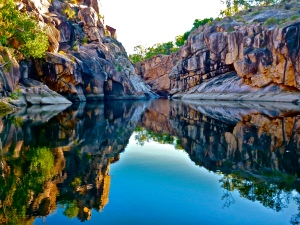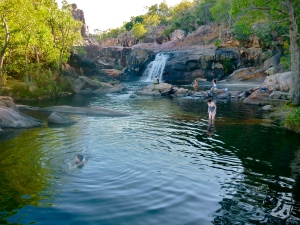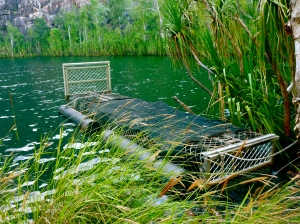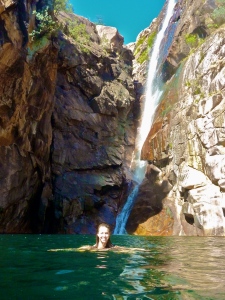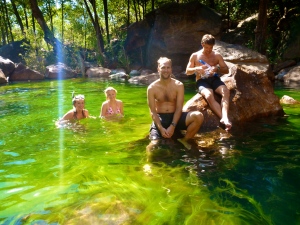Today we began our tour of Kakadu National Park. The aboriginals actually called it Gagudju, but when they tried to tell this to the white man, they miss-heard it as Kakadu and the name stuck! Kakadu is listed as a World Heritage Area in recognition of its unique mixture of culture, biodiversity, and natural values. The park covers nearly 20,000 sq km and is home to numerous plants and animals that are not found anywhere else in the world, many of which are threatened or endangered. Many of the locations in the park are only open to the public for a few weeks out of the year due to harsh weather conditions (especially during times of flash flooding and forest fires), so it’s really special how much of the park we were/are able to see. Basically the main views we missed are in the Jim Jim Falls and Twin Falls Gorge Region. Those are probably the most highly marketed areas of Kakadu, so guides usually feel obligated to bring their groups there. However our guide feels confident that we are seeing the best and most underrated (non-ventured) regions of the park. Exciting! Apparently the best times of the year to come are at the very beginning of the dry season (right now), and smack dab in the middle of it when all the flowers are in full bloom for a short period of time.
The East Alligator region was our first experience of the day – home to rainforest, stone country, floodplains, and centuries worth of Aboriginal rock art. (No, there are no alligators in Australia; the name is very misleading.) We had a leisurely 1km hike around Ubirr (Oo-beerr) with our furthest destination being a 250m climb for a lookout over the Nadab floodplain.

Nadab floodplains
I need to review the movie another time, but apparently there’s a scene with Crocodile Dundee standing on this same rock, calling for help from the Aboriginal people. My apologies if I captured a different angle from the movie, but this was a great view of the floodplains.
Ubirr is best know for its rock paintings that cover the area and dating as far back as 20,000 years old.

20,000 year old Aboriginal rock art
Because there is no carbon in these paintings, fluorescent lights are used to determine the age, the theory being that the brighter the colors appear under the lights, the newer the paintings are. These particular paintings reflect little to no light at all.
Other paintings are clearly more recent even without proof from the fluorescent lights because of their higher attention to detail. As their hunting methods became more efficient, the people were able to spend more time on their art. The Aboriginal people chose to paint because they either had important stories to tell or they were thanking the land by recognizing the lives they had to take in order to feed themselves. Therefore many of the pictures that you find show kangaroos, wallabies, barramundi and other types of fish found in this area.

200 year old Aboriginal rock art - turtle
The pictures relating stories were typically set up in an area resembling a natural classroom setup.

Ubirr "classroom"
The stories are rather harsh, but I suppose they found it necessary to get their point across. One story involved two sisters (ancient ancestors of the Aboriginals) who always used to prank each other by turning themselves into crocodiles and scaring the other sister. Finally the sisters agreed to make the change permanent, so they remained as crocodiles, and their bodies were made into constellations in the stars. Now when little Aboriginal children get too close to the waters edge, the sisters will drop down from the sky and snatch them up. (So long as the message provides the same results, I guess that’s better than being attacked by a crocodile.)
Another story told of an Aboriginal man who had been out fishing all day and then fell asleep on the bank before returning home to his family. One of the men in his tribe saw the pile of fish and stole them for his family. When the sleeping man woke up, he returned to the village to find this other man laughing and bragging about how he stole the fish. When the thief fell asleep, the other man blocked the entrance to his cave with stones so that the fire inside eventually ate up all the oxygen and suffocated his entire family. Brutal, but it shows that your actions have an effect on all those around you as well.

fisherman
Following our Ubirr visit, we hopped in the car to make our way to the Noulangie region. We hiked 3-4km to the Gubara (Goo-bar-rar) Pools with about an hour-long detour via an unmarked path up to The Castle, a cave that overlooks the monsoon forest and sandstone cliffs through which we had just walked. It was significantly cooler in the cave’s shade, so we caught our breath, polished off the remainder of our water, and enjoyed the amazing views in the distance and the forgotten Aboriginal paintings around us.

The Castle

view from inside The Castle
We were thrilled to reach the Gubara pools themselves for a quick dip, and a refill for our water bottles in the crystal clear waterfall in The Garden of Eden. Of course, right behind the fall was a mighty silver-skinned python glaring at us for sharing his water. Was the snake in the biblical Garden of Eden by chance a python? In retrospect, that seems a little ominous. I forgot to take any pictures here… so I guess I didn’t really go there!
After our hike back, we grabbed a few biscuits (cookies) for a short transit to the Nawurlandja Lookout trail. It was a moderately steep climb of 600m with very rewarding views of the Nourlangie mountain range and Anbangbang Billabong. Of course, the billabong was home to yet another scene in Crocodile Dundee in which the woman is almost eaten by a crocodile before Mr. Dundee rescues her. I’m beginning to love the little Crocodile Dundee anecdotes provided by this tour! It’s just perfectly cliché!

Nawurlandja Lookout

looks like the Sydney opera house!

mysterious sinkhole overlooking the Anbangbang Billabong
We caught a gorgeous sunset on the ride to our new campsite in Cooinda, part of the Yellow Water region. This sets us up nicely for tomorrow when we will head to the Mary River region in the most south part of Kakadu National Park.

Kakadu sunset
Tags: Australia, Crocodile Dundee, ecotourism, Indigenous Australian art, Indigenous People, Kakadu, Kakadu National Park, Northern Territory, Rock art, Travel, Travel and Tourism, Ubirr, World Heritage Site
